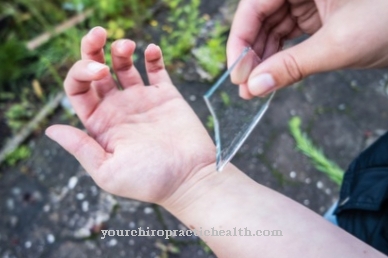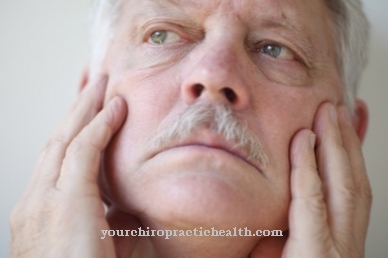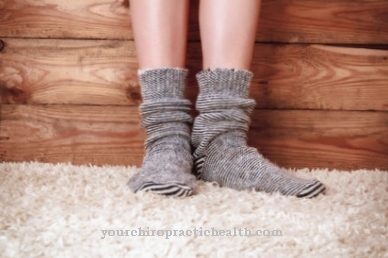Unpleasant Bone pain are often confused by laypeople with pain in the supporting, muscular and ligamentous apparatus and require precise and comprehensive diagnostics to distinguish them.
What is bone pain?

Bone pain is called painful impairment of the bones and joints. Bone pain occurs in older people and adults as well as in children and adolescents. The latter group of people often complains of bone pain in their legs.
As a rule, bone pain in advanced age is related to the entire skeleton and predominantly includes the ribs, the bones of the spine and the pelvis. Bone pain can occur both under physical exertion and at rest and also manifest in the form of what is known as tennis elbow.
In addition, bone pain can be the trigger for various secondary diseases. In addition to being dependent on pain killers, those affected suffer from a significant reduction in their quality of life and sleep poorly. This, in turn, can favor mental illness.
causes
The causes that lead to more or less severe bone pain are quite different in nature. Depending on the localization of the bone pain, clear indications of the possible causes can be seen.
In addition to regionally manifested bone pain, generalized bone pain can also be caused by incorrect loading of the bones and joints. In addition, muscle tension also contributes to bone pain. Some pre-existing or concomitant diseases such as cancer or tumors can lead to an impairment of the bone structure. These also give rise to bone pain. Especially for tumors with a widespread spread of metastases or tumors of bone tissue, bone pain is largely typical. If osteoporosis has manifested itself or after an accident, bone pain is also noticeable.
In the elderly, degenerative diseases and damage to the kidneys also cause bone pain. Diseases that are associated with a sharp increase in body temperature, as is the case with dengue fever, and colds with a high fever also contribute to painful discomfort to the bones. Advanced hepatitis A, borreliosis and gluten intolerance are classic triggers for bone pain.
You can find your medication here
➔ Medicines for painDiseases with this symptom
- Tennis elbow
- Dengue fever
- cold
- Celiac disease
- cancer
- Osteoporosis (bone loss)
- Hepatitis A
- Plasmacytoma (multiple myeloma)
- tumor
- Metastases
- Acute kidney failure
- Cushing's disease
diagnosis
Diagnosing bone pain can be quite difficult when it involves the whole body. In the case of bone pain that can be clearly localized and originates from fractures, diagnosis can be made with palpation and by using X-ray technology. In addition, procedures such as bone density measurements, blood counts and laboratory tests of urine and serum as well as special tests are possible in the diagnostic examinations for the treatment of bone pain.
Complications
The possible complications of bone pain are many and depend primarily on the person who triggered the pain. A distinction must be made between relatively harmless causes of bone pain and serious underlying diseases. Acute, harmless bone pain occurs in some cases in athletes due to excessive stress on the muscles.
The pain then radiates into the bones. In this context, minimal bruises of bones, such as the shins, are possible. Such bone pain usually disappears quickly and rarely leads to complications. Sometimes, however, bone pain is caused by malignant diseases, such as bone cancer or metastasis in the area of the bones.
A lack of treatment then leads to life-threatening complications as the cancer spreads unhindered. If internal organs are infested, there is a risk of serious complications, including organ failure, so that patients sometimes die. For this reason, long-lasting bone pain should always be examined by a doctor.
Therapy for bone pain also sometimes results in complications. During surgical interventions in the area of the bones there is a risk of injuries with far-reaching consequences. For example, some patients suffer from complications during or after bone operations, sometimes paralysis or other mobility restrictions. These disabilities are either temporary or permanent, but in any case impair the patient's ability to cope with everyday life independently.
When should you go to the doctor?
In healthy people, the bones rarely hurt. Therefore, bone pain is a reason for a doctor's visit regardless of age and health. Children are likely to have growing pains - they tend to appear in the afternoon until late at night and go away in the morning. Since bone pain is not automatically growing pains, but could also indicate rare types of cancer or growth disorders, the pediatrician should confirm that the symptoms are really harmless.
In an adult, bone pain can occur from excessive stress on the bones, for example after heavy hauling. However, such pain can also be caused by the fact that stress has already left damage to the bones. If bone pain recurs or does not improve after the first observation, a doctor should examine where it came from and how it can be treated. Damage to the bones is not always reversible, which means that some impairments to the bones no longer heal properly.
In the case of recurring, regular bone pain, there is also a suspicion of a disease of the bones, for example arthrosis or osteoporosis. Severe, sudden bone pain with symptoms such as dizziness, nausea, or a large bruise on the painful area indicates a broken bone. A broken bone must be treated immediately by a doctor. The person concerned must either be taken to the doctor or picked up by the ambulance, as in this case they can no longer make the journey on their own.
Doctors & therapists in your area
Treatment & Therapy
A wide variety of therapeutic methods are used to treat bone pain. Which methods are used for bone pain depends on the result of the diagnosis, the extent and the causes and localization of the bone pain.
If bone pain remains untreated, this can pose a high risk for the further health and performance of those affected. If the bone pain occurs due to incorrect loading or tension, physiotherapy exercises and massages as well as appropriate medication help.
On the one hand, the bone pain is alleviated with the usual and proven conventional medical measures, on the other hand, however, also with alternative medical approaches such as homeopathy. In addition to taking painkillers and additional vitamin A for deficiency symptoms, special medication is required, for example for rickets or osteoarthritis, to reduce bone pain.
If the bone pain is cancer or a so-called plasmacytoma, chemotherapy and additional radiation therapy of the tumor are essential.
Outlook & forecast
If the bone pain is caused by a broken bone, it must be treated immediately by a doctor. The sooner treatment occurs, the higher the chances of the fracture healing completely. In most cases, it will take several weeks for the bones to grow back together. During this time the pain can be relieved with the help of painkillers, but this should not be done for too long.
If the muscles are overloaded, bone pain can also occur. These disappear again when the muscles are rested and relaxed. The patient is often restricted by the bone pain and cannot move independently. He is dependent on crutches or a wheelchair.
Severe bone pain without a previous accident can indicate problems with the internal organs. Whether a cure is possible in this case depends heavily on the severity of the symptom. In any case, bone pain should be evaluated by a doctor if it persists for several days or if it causes excruciating pain.
You can find your medication here
➔ Medicines for painprevention
In order to prevent bone pain, a balanced diet, physical activity and the avoidance of poor posture and one-sided stress on the bone and supporting apparatus are important. To prevent bone pain caused by osteoporotic causes, the bones and muscles should be strengthened through targeted nutrition and effective medication.
If certain signs of a disease that are associated with bone or limb pain occur, it is advisable to see a doctor in good time. This can counteract a further worsening of the bone pain and even eliminate it completely. Sometimes tried and tested home remedies and herbs also help prevent bone pain as rub-in.
You can do that yourself
If the bone pain occurs due to a broken bone, self-help is not possible. In this case, the person concerned must immediately consult a doctor so that there are no late effects. Dizziness or vomiting can also be associated with a broken bone.
The bone pain can be numbed with pain medication for a short period of time. Long-term use of pain medication is not healthy and should not be done. The affected area on the body can be treated with the help of heat and cold. Baths, a visit to the sauna and cooling the respective area with ice or a cooling pad help here. Creams and ointments with a cooling effect on the skin also help. In most cases, the bone pain disappears after a few days.
In general, a healthy diet with lots of vitamins and nutrients helps against bone pain. These promote the healing of bones and muscles. The body should not be exposed to unnecessary stress when there is bone pain. Above all, the affected areas may only be stressed or used a little. If it is a broken bone, healing can also be accelerated by eating healthy food and not moving the broken area much.



.jpg)























